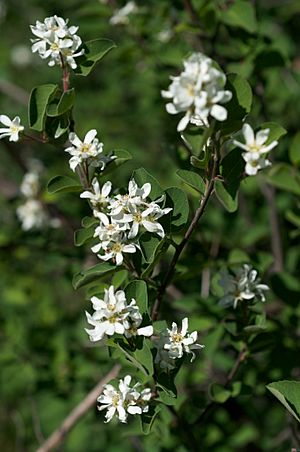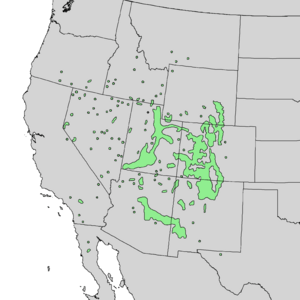Utah serviceberry facts for kids
Quick facts for kids Utah serviceberry |
|
|---|---|
 |
|
| Scientific classification | |
| Genus: |
Amelanchier
|
| Species: |
utahensis
|
 |
|
| Natural range of Amelanchier utahensis | |
The Utah serviceberry (scientific name: Amelanchier utahensis) is a cool shrub or small tree found in western North America. It's a type of serviceberry plant. You can spot it growing in many different places, from sunny, open hillsides to thick forests.
Contents
What Does the Utah Serviceberry Look Like?
The Utah serviceberry is a plant that spreads out. It can grow up to about 5 meters (that's about 16 feet) tall. This plant is deciduous, which means its leaves fall off at the end of the growing season, usually in autumn.
Its leaves are green and can be round or shaped like a spade. They often have small teeth along their edges, especially on the upper half.
Flowers and Fruits
In April and May, the Utah serviceberry blooms with pretty white flowers. These flowers grow in short clusters called inflorescences. Each flower has five narrow petals that are spaced out.
After the flowers, the plant grows small fruits. These fruits are called pomes, which are a type of fruit like tiny apples.
Who Eats the Utah Serviceberry?
Many animals enjoy eating the Utah serviceberry. These include wild animals like desert bighorns, elk, and mule deer. Many different birds also eat its fruits. Even farm animals, like livestock, will browse on this plant.
Where Does the Utah Serviceberry Grow?
The Utah serviceberry lives in a large area across western North America. Its main home is in the Rocky Mountains. This includes parts of Colorado, New Mexico, and Wyoming in the east. To the west, it grows in the Front ranges of Utah. In the south, you can find it in central Arizona and western New Mexico. This southern area includes places like the Mogollon Rim and the White Mountains (Arizona).
The plant also grows in the mountain ranges of the Great Basin. It stretches west to the Sierra Nevada mountains in California. You can even find it in the California chaparral and woodlands and as far south as northern Baja California. To the north, its range reaches into southwestern Montana and Idaho.


